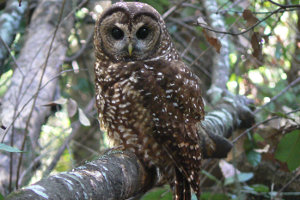[jwplayer config=”QUEST Audio Player” skin=”http://ww2.kqed.org/quest/wp-content/themes/quest/glow.zip” file=”http://www.kqed.org/.stream/anon/radio/quest/2011/05/2011-05-02-quest.mp3″ ]
Listen to the QUEST radio story Spotted Owls Face New Threat
“So this would definitely be a pair. They’re hanging out together,” says Merkle.
Northern spotted owls aren’t very big. They’re a brown owl with white spots that’s found from Washington state down to the Bay Area. They’ve also had the starring role in a decades-long battle between loggers and wildlife groups over their habitat. In many logging towns in the early 1990s, this owl was public enemy number one.
Merkle says in all, about 80 pairs of spotted owls are found on national park land in Marin County – and for 15 years, the park service has monitored the health of that population.
But recently, Merkle says they’ve been hearing a new owl call in the forests – a barred owl call.
Arrival of the Barred Owl
“The call often described as ‘who cooks for you?” says David Press, another ecologist with National Park Service. He’s joining Merkle near Muir Woods to look for the owl that makes that call – the barred owl.
“You see anything?” says Merkle. They peer into a hollow cavity high in a tree – a cavity that used to be a spotted owl nest.
“Just at the base of it you can see a little bit of that barred owl,” says Merkle. It’s a female barred owl, sitting on her eggs. Merkle looks concerned.
“It’s a troubling picture for the spotted owls,” he says.
Barred owls are an invasive species, originally from the Eastern US. They first arrived in spotted owl territory in Washington and have been moving south down the coast – which makes this owl the frontline of the invasion.
“The barred owl is a little larger. It’s a little more aggressive. And so in other areas where you have barred owls set up, the spotted owls aren’t there anymore,” says Merkle.
Barred owls take over spotted owl territory and in some cases, even attack them. In places like western Washington, the spotted owl population has been cut in half since the barred owl showed up.
David Press says he’s already seeing a change in Marin. “Since the barred owls moved into the area, we’ve had a harder and harder time detecting spotted owls where they have been historically.”
“The barred owls are really sort of adding insult to injury,” says Paul Henson of the US Fish and Wildlife Service, the agency overseeing spotted owl recovery.
“The injury for the spotted owl was 100 years of habitat loss, and the sort of insult, the more recent insult, is barred owls have now shown up and are really out-competing spotted owls.”
New Study to Remove Barred Owls
The Fish and Wildlife Service hopes to deal with the issue in a new plan expected to be released in a few weeks. It includes a barred owl study that’s… raising a few eyebrows.
“We identified the need to do a focused study where we could test the response of spotted owl populations to the removal of barred owls,” says Robin Bown, a biologist with Fish and Wildlife.
Which means…
“Well, basically it means permanent removal. We’re going to look at all potential opportunities but the most humane way to do it is to shoot them. A shotgun removal is extremely quick, it’s almost instantaneous.”
Bown says they plan to eliminate barred owls from a few study plots to see if the spotted owls there do better. They also want to see if it’s even feasible to remove barred owls by shooting them.
And yes, Bown says this is an idea that’s not easy to consider. “Oh it’s a very difficult thing. Even for those of us involved in this, it’s a very difficult concept to say I’m going to kill one species to try to save another species. But it’s also something that in some cases we need to do.”
Back in Muir Woods, Bill Merkle says a lot of people are waiting on the results of the study to see what’s next.
Budget cuts are also an issue. Just as more barred owls are arriving, Merkle says the park service’s owl monitoring program has been cut.
“Now the situation is getting a lot more challenging just when I think the threats are getting more apparent with the barred owls. We know climate change is going to change things out here. It is a difficult time to be cutting off our monitoring.”
If approved, the barred owl removal program would begin next year.
37.89705 -122.58110
 A northern spotted owl in Marin County. Credit: National Park Service.
A northern spotted owl in Marin County. Credit: National Park Service.